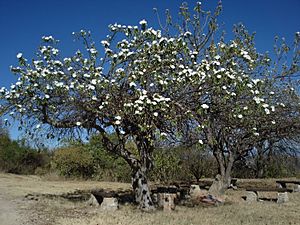Tree morning glory facts for kids
Quick facts for kids Tree morning glory |
|
|---|---|
 |
|
| Scientific classification | |
| Genus: |
Ipomoea
|
| Species: |
arborescens
|
The tree morning glory, also known as Ipomoea arborescens, is a fast-growing flowering tree. It belongs to the Convolvulaceae family, which includes many morning glories. This tropical plant is mostly found in Mexico. It blooms with beautiful flowers in late autumn and winter. Its common name in Nahuatl, a native language in Mexico, is Cazahuatl or Cazahuate.
Contents
Where It Grows
Ipomoea arborescens is found across a large part of Mexico. It grows from Sonora and Chihuahua in the north down to Veracruz and Oaxaca in the south. You can find it at different heights, from 50 to 2200 meters above sea level. It usually flowers and produces fruit between November and April. This tree lives in open thorn forests, oak savannas, and dry forests where leaves fall off in the dry season. People also grow this plant in countries like El Salvador, Guatemala, Senegal, and Zimbabwe.
Its Home and How It Lives
The tree morning glory is a special type of tree that loses its leaves. It also has a thick, swollen base or trunk, which helps it store water. It needs lots of sunshine to grow well. This tree thrives in warm, tropical places. It grows best in soil that is slightly acidic to slightly alkaline, with a pH between 6.1 and 7.8. The tree grows its leaves in the summer when it rains a lot. After the rainy season ends in September, the tree sheds its leaves.
What It Looks Like
This tree grows very quickly, sometimes up to two or three meters each year! It can reach a height of 3 to 15 meters. Its trunk can grow up to 50 centimeters wide. The bark is usually grey to brown and feels rough. When the stems are young, they are covered in soft hairs. After about three years, they become smooth. The tree also produces a white, milky sap, which is found throughout the wood.
The leaves are shaped like an egg or a spear. They are usually 9 to 19 centimeters long and 6 to 9 centimeters wide. Each leaf has 12 to 19 pairs of veins on the sides. The base of the leaf is heart-shaped, and the tip is pointed. The leaves are hairy, especially on the underside and along the veins. As they get older, the hairs remain mostly on the veins and edges.
Flowers and Fruit
The flowers of the tree morning glory grow in small groups. These groups are found at the ends of branches or where leaves meet the stem. Each group usually has one, or sometimes two, flowers. The flowers are shaped like a funnel and are white or cream in color. A greenish or cream-colored cup-like structure, called a calyx, holds the wide, white flower petals. The stamens, which are the parts that produce pollen, are hidden inside the flower's opening.
After flowering, the tree produces a fruit capsule. This capsule can be round or long and narrow. It holds four dark reddish-brown seeds. Each seed has a fringe of white or yellow silky hairs. The flowers of the tree morning glory are a very important source of nectar. Many animals, like lesser long-nosed bats, hummingbirds, and bees, visit the flowers to drink their sweet nectar. Deer also like to eat the flowers that fall to the ground.
Tree Problems
The tree morning glory can get a disease called stem rot. This happens if it comes into contact with a type of fungus called Fusarium oxysporum. The disease is more likely to occur in wet conditions. When there is a lot of moisture, the fungus releases tiny spores. These spores cause the plant to swell up and damage its internal water transport system. Some signs that a tree has this disease include slow growth, fewer flowers, and yellow leaves. If the disease is not treated, the tree might die.
Other Names for the Tree
Ipomoea arborescens has many different names! Some of these include:
- Palo blanco: This means "white stick" in Spanish.
- Palo muerto: This means "dead stick."
- Palo santo: This means "holy stick."
- Palo bobo: This means "silly stick."
- Ozote
- Casahuate blanco
- Palo cabra: This means "goat stick."
- Sacred morning glory tree
It also used to have an older scientific name, Convolvulus arborescens.
See also
 In Spanish: Ipomoea arborescens para niños
In Spanish: Ipomoea arborescens para niños

